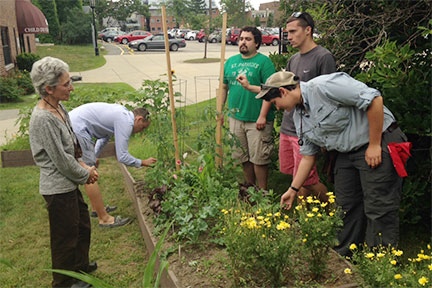Lessons in Gardening

by Nicole Bateman ’16
What do you do in a course called “Ecological Agriculture: Farming and Gardening with Nature in Mind”? You learn about farming and gardening and you try your hand at it. Adjunct Professor Tatiana Schreiber and her students in the summer environmental studies course sampled blueberry kale smoothies made with kale they grew on campus, conducted an experiment to determine the effects of planting vegetables alongside flowers that attract pollinating insects, and learned about ecological farming in different regions around the world.
Growing herbs and vegetables “is a lot more involved than I expected,” said student Max Kliegle, noting that he learned how important it is to plant cover crops, which aren’t for eating but are used to help bring nutrients up through the soil, making it richer for the crops that will be harvested.
What exactly is ecological farming? The course materials explain it: “The approach of ecological agriculture attempts to mimic natural ecosystems in the garden, while at the same time recognizing that gardening is inherently a human-ordered activity. We can only scratch the surface of understanding nature’s processes; yet, by closely observing the ecosystem in which we find ourselves, we can strive to create in our gardens conditions that as closely as possible reinterpret ecosystem dynamics within our gardens and surrounding landscapes.”
The students did so by setting up an experiment on campus using four vegetables beds. They planted tomatoes, kale, corn, and rice in all four, and added flowers and herbs to the two experimental beds to attract pollinators and provide habitat for beneficial insects and to possibly deter some potentially harmful insects. They also planted cover crops – vetch, oats, and clover – in the experimental beds. By the end of the six-week course, the garden was well under way.
“In the bed that had the vetch in it,” said student Aaron Calkins, “the tomatoes grew much taller than in the bed that did not have any vetch as a cover crop, which I thought was kind of interesting. So I guess the vetch helped.”
One of the students, Grace Talmadge, who is working on campus this summer, will be monitoring the growth of the vegetables in the experiment over next few weeks.
Each student also undertook an individual research project to present to the class. Talmadge focused her project on school gardens, while Chris Deegan studied farming in urban areas. Deegan noted that most gardeners in Detroit plant in abandoned lots, which not only helps the neighborhood look more aesthetically pleasing but can help build community bonding. Kliegle did his project on the hazards facing bees and other pollinators, and Calkins looked at backyard agroforestry.
What else did they learn? For one thing, that it’s very handy to know how to grow your own food, spices, herbs, and other useful plants. And they put their efforts to good use: the cherry tomato crop will be available for the kids in the campus Child Development Center—just a few steps from the garden beds—to watch grow, to pick, and to eat.
“For a six-week class,” says Schreiber, “I think we were able to do a lot.”





